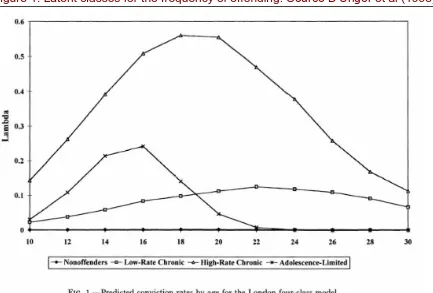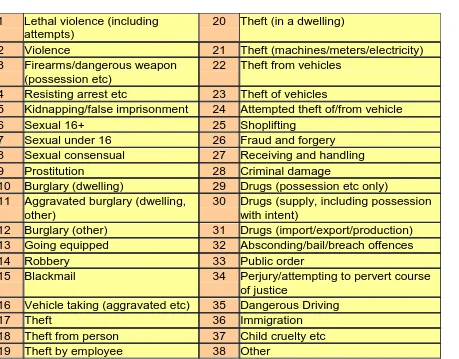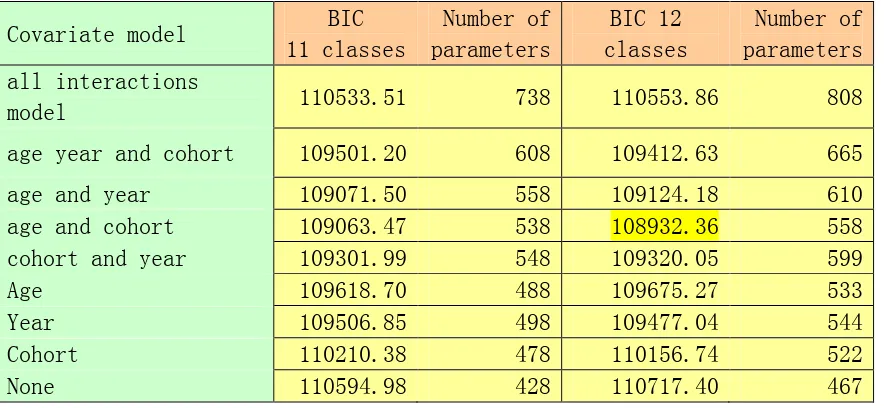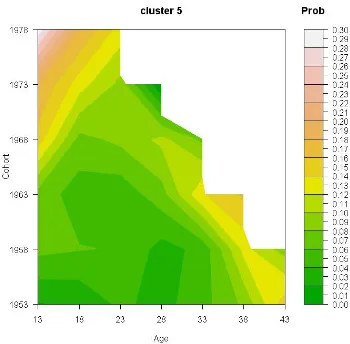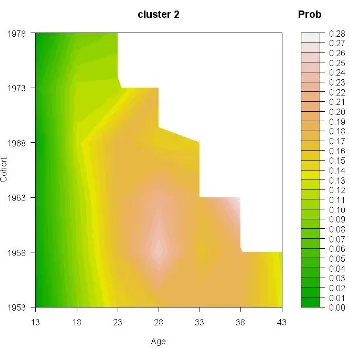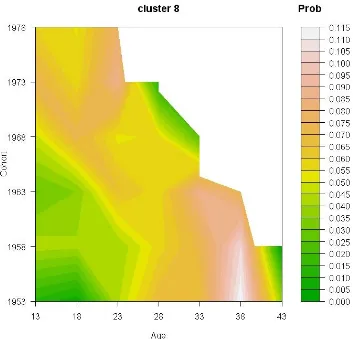Using the Offenders Index to investigate patterns of offending
Brian Francis, Jiayi Liu and Keith Soothill
*
Centre for Applied Statistics, Lancaster University, UK
Paper given at the 13th Government Statistical Service Methodology conference, 23 June, 2008, The Congress Centre, London
Corresponding Author: Brian Francis
Address for correspondence:
Brian Francis,
Centre for Applied Statistics Fylde College
Lancaster University, Lancaster LA1 4YF UK
Abstract
The Offenders Index is a rich data source which consists of criminal conviction information collected from the courts. While it has been used to identify, for example, the proportions of particular birth years which have had a criminal conviction, there has been little interest in how the types of offences which offenders are convicted change over time.
In this talk, we describe the problem of identifying patterns of offending
Introduction
The aim of this paper is to provide a general overview of an ongoing research programme on criminal careers which seeks to use the Offenders Index to explore a variety of issues related to changing patterns over time. In our work there are both
substantive issues - which involve investigating changes in the patterns of criminal careers over the life course and specifically focusing on the nature of offending - and
methodological issues – which involve developing new methods for assessing
changes in the nature of offending over time and to take advantage of modern administrative datasets such as the Offenders Index. After a brief summary of some of our work to date, this paper provides some initial thoughts and preliminary findings on disentangling age, period (or year) and cohort (or generational) effects when considering changes over time.
Focusing on age, period and cohort effects highlights our attempt to work on important substantive, methodological and statistical matters relating to criminal careers. The study of criminal careers is a burgeoning research area but
understanding age, period and cohort effects is a comparatively neglected area. There are at least three reasons. Firstly, criminologists have not fully grasped the importance of the topic. Secondly, there are methodological issues to confront as datasets are difficult to obtain which can be used to probe the topic. Finally, there are some crucial statistical issues which also need to be addressed. As stated, we
present some initial thoughts and preliminary findings. But, first, some of our work so far in the area of criminal careers.
Research to date
Our team has been operative for over fifteen years embracing topics in both crime and health. However, our focus more specifically on criminal careers began with an analysis of a long-term follow-up of white-collar offenders (Soothill et al., 1997; Soothill et al., 1999a) and a similar long-term follow-up of sex offenders (Soothill and Francis, 1997; Ackerley et al., 1998; Soothill et al., 1998; Soothill and Francis, 1999; Soothill et al., 2000; Escarela et al., 2000; Soothill et al., 2002d;
Soothill et al., 2005a, b). Our interest then embraced homicide (Soothill et al., 1999b; Francis and Soothill. 2000; Soothill et al., 2002b, 2002d; Francis et al. 2004) together with a specific focus on the media coverage of homicide (Soothill et al., 2002c; Peelo et al., 2004). Methodological issues came to the fore in grappling with the concept of crime seriousness (Francis et al., 2001). In parallel, an interest developed on some specific serious offences (e.g. incest (Soothill and Francis, 2002); arson (Soothill et al., 2004b), perjury (Soothill et al., 2004c); kidnapping (Soothill et al., 2007; Liu et al., 2008)) and more recently on the inter-relationships and sequencing of selected serious offences (e.g. Soothill et al., 2008b).
However, throughout the last five years a more general focus on patterns of offending has also emerged (Soothill et al., 2002a; Francis et al., 2004a).
Increasingly, we have become interested in the issues of changes over time (e.g. Soothill et al., 2003, 2004a; Francis et al., 2004b; Francis and Soothill, 2005; Francis et al., 2007; Soothill et al., 2008; Soothill et al., in press). It is this latter interest which underpins the substantive and methodological issues raised in this paper.
Importance of age, period and cohort models
It is important to clarify why we are interested in trying to separate out the effects of age, period and cohort effects for, as already mentioned, it has not been an issue – with some notable exceptions – that has engaged criminologists. There are probably at least two reasons for this. Mainly it is because, as we shall argue later, criminological explanations have tended – both traditionally and in contemporary times – to be somewhat static. In short, they have tended not to consider or to
embrace change. In fact, this has become more of a problem in the last decade or so as criminological discourse, certainly in policy terms, has been increasingly
dominated by a psychological framework. With the focus on the individual, societal change has tended to be disregarded. In contrast, sociologists who, for around a quarter of a century from the mid-1960s, provided the dominant discourse in
criminology recognised the importance, both potential and actual, of changes within and between societies but rather lacked the wherewithal and the tools to analyse change. The wherewithal consisted of appropriate datasets to attempt to measure change while the tools included the appropriate statistical techniques which needed to be sharpened for the task.
Within this ocean of neglect, one of the important exceptions in focusing upon change was the work of the illustrious, but sadly late, criminologist, Leslie Wilkins who started his career as an engineer, eventually becoming Deputy Director of the Home Office and then subsequently emerging as a famous professor of criminology at the Universities of California and then New York in the United States. Wilkins had the fairly unusual attributes of being a criminologist – his book, Social Deviance: Social Policy, Action and Research, should be regarded as a minor classic – and a
statistician. Wilkins‟s work on considering so-called „delinquent generations‟ involved the development of an ingenious dataset and the use of statistical techniques which are both enterprising and challengeable. Certainly his work produced a minor flurry of debate on the methodological foundation of his work which both supported (e.g. Pullum, 1977) and challenged his thesis (e.g. Rose, 1968). In a thoughtful
contribution, Farrington brought the debate to a rather premature conclusion by suggesting that Wilkins was proved to be wrong. However, the story is certainly not complete in terms of understanding age, period and cohort effects. Probably most criminologists are perhaps relieved that the matter is not currently a flavour of the month, for the technical issues to confront are undoubtedly daunting. Nevertheless, one should not underestimate its importance criminologically.
In brief, the question is whether changing patterns of crime are due to:
i. Age effects The relationship of age to crime is well known. Age effects are often thought of as biological or psychological processes affecting the teenage years, or decreasing parental controls in that period (Farrington, 1986).
There may also be age interactions with year if, for example, the government targets certain age groups with policy initiatives.
Changing patterns of crime
The phrase, „changing patterns of crime‟, makes an important assumption, that is, patterns of crime are, indeed, changing. Certainly it seems uncontentious that over time crime does change. Motoring offences dominate the criminal statistics but, obviously, before the arrival of the internal combustion engine, traffic offences were of a different order. Whether the arrival of the internet actually changes the nature of crime – in other words, new crimes actually emerge – or simply the internet enables old crimes to emerge in a different form (for example, new kinds of deception) is arguable, Nevertheless, there seems little doubt that crime – both quantity and quality – does change over time. Our focus, however, is more specific. We are interested in whether „patterns of offending‟ change over time. So, for example, is violence increasing while property offences are decreasing? Are violent offenders specialists or are they involved in other activity?
In order to measure changes in patterning, one needs to confront the long-standing problem in criminology, namely, that of classifying criminal behaviour. This is not the place to review this early work but we will simply point to an important distinction. Early work in criminology, say in the 1970s, attempted to classify a criminal – thus, an offender might be judged as a robber, a trickster and so on. Don Gibbons (1962) was probably the prime exponent of this approach. The outcome envisaged was that an offender then has that label throughout his or her career and so having all the problems that the label provokes in terms of the difficulty of finding jobs etc. – Lemert (1967) characterises these effects as „secondary deviance‟. In fact, identifying criminal typologies raises many concerns. Certainly very little of this work was based on real life data so the subtle nuances of criminal careers are missed and there were significant issues in deciding how to allocate offenders to a class. In fact, Gibbons himself seemed to present an obituary to this approach in his articles in the British Journal of Criminology (1975)and Criminal Justice and Behaviour(1988).
In short, criminal typologies, becoming close to criminal stereotypes, still may have a resonance in fictional representations, but their use in criminology has been
downplayed in recent years.
In contrast, our own work has begun to focus on the classification of crime, not the criminal. We are not alone in focusing on this approach, for it underpins routine activity theory (Cornish and Clarke, 1986). However, we are trying to identify types of criminal activity in distinct age groups and, hence, this can be seen as embracing a developmental approach. In brief, it allows the development of an offender moving from one crime type to another. So, if one is looking for a criminological pedigree, it essentially follows the approach of Sampson and Laub (1993) in probing pathways through crime.
longer term, one would like to be able to model both quantity and quality of offending over time, but perhaps it is useful to distinguish these terms analytically at this stage.
Figure 1 (taken from D‟Unger et al, 1998) shows a typical outcome of the approach considering the quantity of offending over time using data from Farrington‟s study. What it essentially shows is that three offending groups and one non-offending group can be identified. The three offending groups can be identified as an
adolescent-limited group, who have highest frequency at age 16, and then decline and stop in their early 20s, and two chronic offending groups – a low chronic and a high frequency chronic group. This typology echoes the theoretical work of Moffitt (1993), who hypothesised such groups.
Figure 1. Latent classes for the frequency of offending. Source D‟Unger et al (1998)
Typologies of crime
[image:6.595.77.510.248.541.2]A rather different approach is to consider the quality or nature of offending over time. Figure 2 shows a simplified invented criminal history of a typical male offender between the ages of 14 and 22 years.
Figure 2 A simplified criminal conviction history for one offender
age 14 17 20 22
Offences Bicycle stealing
Shoplifting; Carrying offensive weapon
Fraud; Petty theft
Fraud; Petty theft;
We would like, for example, to determine whether bicycle stealing and shoplifting tend to co-occur in the cohort of which this offender is a part; similarly, whether fraud and receiving stolen property co-occur, and at what ages these offences are most prevalent. When one is faced with a whole range of criminal histories of this kind, the task is the difficult one of description.
The Offenders Index data set
For this study, we use the England and Wales Offenders Index– a Home Office research data set, which is a court based record of the criminal conviction histories of all offenders in England and Wales from 1963 to the current day.
The complete data set is rarely analysed. We analyse data from the Offenders Index Cohort study (Prime et al 1999), taking six birth cohorts born in 1953, 1958, 1963, 1968, 1973, 1978 and followed through to 1999. This birth cohort is an
approximate 1 in 13 sample of all offenders born in the sampled years, and samples all offenders born in four selected weeks. The convictions stored are standard list offences – which consists of all indictable convictions and some more serious summary convictions. The index stores dates of conviction, the offence code of the conviction (very detailed) and the disposal or sentence.
The dataset has numerous advantages for examining patterns over time. First, there is a high degree of consistency over time. The definition of standard list offences has not changed dramatically over the 36 years of the study, coupled with this is the length of the database – with over 36 years of data. However, there are disadvantages. First it does not contain information on death, or immigration, or emigration. An individual might have left the country (perhaps to Scotland), but this would be viewed as a period of not offending in the dataset. Secondly, there is the method on which the dataset is formed. The dataset is formed by record matching, taking court records and matching them on name and data of birth to form criminal histories. Although this procedure compares well with police records (Francis and Crosland, 2002; Home Office) it can introduce inaccuracies. Finally there is a problem with all long-term longitudinal datasets – new offences are passed into law, or some offences become viewed as more or less serious and therefore definition of standard list offences change over time We deal with this by removing all offences which become standard list or stop being standard list over the 36 year period.
To carry out our study, we need to simplify the data, reducing the more than 2000 offence codes to 38 major offences, after combining categories. The philosophy we take to do this is to combine offences which are of the same nature but differ only in severity. Thus common assault is combined with other non-lethal violence
Table 1. The 38 broad offence codes used in the study.
1 Lethal violence (including attempts)
20 Theft (in a dwelling)
2 Violence 21 Theft (machines/meters/electricity) 3 Firearms/dangerous weapon
(possession etc)
22 Theft from vehicles
4 Resisting arrest etc 23 Theft of vehicles
5 Kidnapping/false imprisonment 24 Attempted theft of/from vehicle
6 Sexual 16+ 25 Shoplifting
7 Sexual under 16 26 Fraud and forgery 8 Sexual consensual 27 Receiving and handling
9 Prostitution 28 Criminal damage
10 Burglary (dwelling) 29 Drugs (possession etc only) 11 Aggravated burglary (dwelling,
other)
30 Drugs (supply, including possession with intent)
12 Burglary (other) 31 Drugs (import/export/production) 13 Going equipped 32 Absconding/bail/breach offences
14 Robbery 33 Public order
15 Blackmail 34 Perjury/attempting to pervert course of justice
16 Vehicle taking (aggravated etc) 35 Dangerous Driving
17 Theft 36 Immigration
18 Theft from person 37 Child cruelty etc 19 Theft by employee 38 Other
Methodology
We adopt a latent class approach to the problem of finding patterns in
conviction histories. We follow a similar approach to that of Francis et al (2004) who, using 75 summary offence groups rather than 38, examined the 1953 Offenders Index cohort separately for males and females, and found ten distinct patterns of male offending and three classes for females. More recently, (Soothill et al, 2008) we considered conviction patterns in 16-20 year olds over all six cohorts, and found a greater variety of offending types, with 15 classes for males and five for females. This paper will examine all six cohorts over all time periods and thus will use the complete Offenders index cohort data from 1963 to 1999. Figure 3 contains a schematic representation of the dataset analysed, with the yellow shaded cells indicating where data is present.
The latent class methodology conceptually finds hidden classes in offending patterns. We search for classes across all age groups and cohorts, but expect that membership probabilities of any class to change over cohort and age.
Formally within an age group we define a set of indicator variables Oija as
Oija =1 if offender i is convicted for offence j
Oija =0 otherwise.
We define Oia to be the prevalence vector for offender j and age group a over the 38 broad offence groups.
Oia = (O1ja
,
O2ia,…
Oija,…
O38ia)
Figure 3. Schematic representation of the Offenders Index birth cohort data.
Age groups No. of
offenders in cohort Birth Cohort 10-15 16-20 21-25 26-30 31-35 36-40 41-45 Male -
female
1953 8851 -
2217
1958 9233 –
2348
1963 10686 –
2569
1968 9126 –
1797
1973 6118 -
1071
1978 3726 –
665 No. of
offenders in age group Male - female
26797 - 4659
47440 - 10667
Assume there are K classes, with k=1…K.
Let π(k) be the probability of membership of class k, and pjk the probability that
there is at least one offence of type j given that the offender belongs to class k. Then the likelihood is
a
i k i
k p k f
L
,
)
(O O
j O jk O jkik p ij p ij
pO 1 1
Thus, π(k) gives the size of cluster k , and pjk the definition of class k. We
omit age groups from the analysis where there is no offending - where the prevalence vector is all zeros. Such a group would simply be detected as an additional non-offending group and would add additional complexity to the analysis.
We can extend this model to allow for differing probabilities of membership. We replace π(k) by π(k|a,p,c) allowing these probabilities to depend on age a, period
p and cohort c. We use a multinomial model to estimate parameters for each latent
class.
k c)} p, a, | (k exp{ c)} p, a, | (k exp{ c) p, a, | (k , where
model) possible one ( effects cohort and period age, involving model linear c) p, a, | (k
k
effects main kc kp ka
Within each latent class, there is the well-known problem of parameter
identification, as there is a linear indeterminacy between the beta parameters if a full main effects model with age, period and cohort terms is fitted (see e.g. Robertson and Boyle, 1992). However, in this analysis we are not interested in the estimates of the beta parameters, but more in examining model fit to see whether age, period or cohort explains the most variation. To do this, the Bayesian Information Criterion (BIC) is used to determine the best model. BIC is best thought of as a penalised likelihood and is defined by
BIC = -2 log L + p log(n)
where p is the number of parameters in the model and n the number of observations. As the number of parameters and the complexity of the model increases, the -2 log L term becomes smaller as the fit improves; this complexity is penalised by the addition of p log(n) term, which becomes larger as p increases. The best model is found by taking the model with the minimum value of BIC.
A final consideration is to bear in mind that maximisation of the likelihood is often a difficult problem. We deal with this by taking 300 different starting value sets for each model and choosing the best fitting model from these results.
Results
We analyse the full data on female convictions across the six cohorts. We adopt a strategy as follows:
b) fit covariate latent class models to models around the 11 class solution. We fitted a variety of models to the 11 class and 12 class solutions. The models included
i) full interaction models fitting a parameter for each age-period-cohort combination
ii) main effect age+period+cohort factor models
iii) two factor models such as age+period
iv) one factor models
[image:11.595.71.513.337.541.2]Table 2 shows the BIC values for a variety of models This strategy found that the 12 class solution with age and cohort effects but not year effects gave the best fit with the lowest BIC value.
Table 2. BIC values for latent class APC models
Covariate model BIC
11 classes
Number of parameters
BIC 12 classes
Number of parameters all interactions
model 110533.51 738 110553.86 808
age year and cohort 109501.20 608 109412.63 665
age and year 109071.50 558 109124.18 610
age and cohort 109063.47 538 108932.36 558
cohort and year 109301.99 548 109320.05 599
Age 109618.70 488 109675.27 533
Year 109506.85 498 109477.04 544
Cohort 110210.38 478 110156.74 522
None 110594.98 428 110717.40 467
Based on these results, we choose the 12 class solution for female offending with the probabilities of group membership varying by age and cohort. It is important to point out that the number of groups for female offending patterns is substantially larger than the five groups found in our study of the 16-20 year olds. On closer examination, this appears to be reasonable. Firstly, we are analysing substantially more offenders - 10667 females rather than the 4659 females used in Soothill et al (2008b). Secondly, we expect new classes of offending to appear to represent patterns which appear in later life but which are uncommon in 16-20 year olds.
There are six specialist offence classes.
Shoplifting (29% of offender-age groups) Theft (9.7%)
Violence (7.7%)
Criminal damage (5.4%) Theft from meters (1.7%) Drugs possession (3.9%)
The specialist offence classes are characterised by having a high pjk for a single offence and a low pjk for all other offences. Thus the shoplifting cluster has a high probability of shoplifting and low probabilities for all other offences in that particular cluster.
Three paired offence groups:
Resisting arrest and absconding/bail offences (7.1%) Receiving and handling with some shoplifting(4.4%) Theft by employee with some fraud (2.8%)
The paired offence classes are characterised by having a high pjk for a two offences and a low pjk for all other offences. Thus the receiving and handling cluster has a high probability of receiving, a probability of shoplifting of around 0.4, and low probabilities for all other offences.
Three versatile groups
Fraud with theft and receiving(12.7%)
Theft with burglary and shoplifting (acquisitive non-violent - 9.0%) Violent acquisitive (shoplifting, theft with some violence – 6.6%).
The versatile offence classes are characterised by having a high pjk for more than two offences and a low pjk for all other offences. Thus the violent
acquisitive cluster has high probabilities of shoplifting and also of theft , with a probability of violence of around 0.4, and low probabilities for all other
offences.
We can see that the shoplifting class is the most prevalent (π(k)=0.290), followed by the versatile offence class of “Fraud with theft and receiving”
(π(k)=0.127) and the specialist offence class of theft (π(k)=0.097). However, these are overall figures taking the prevalence rate over the entire sample; and we know from the statistical model for π(k) that the prevalence varies by age and cohort.
Table 3. Changing proportions of the violence only female offending group.
Age Cohort
11-15 16-20 21-25 26-30 31-35 36-40 41-45
1978 0.29 0.18 0.13
1973 0.18 0.13 0.09 0.00
1968 0.15 0.07 0.09 0.11 0.07
1963 0.07 0.05 0.05 0.07 0.14 0.16
1958 0.07 0.06 0.06 0.04 0.05 0.13 0.09
1953 0.02 0.02 0.04 0.03 0.05 0.0 0.15
In this table, the cohort effects are rows, the age effects are columns and the year effects are top-left to bottom-right diagonals. We can see that the highest proportion is observed in the 1978 birth cohort for those aged 11-15. 29% of those convicted in that age group and cohort are estimated to be violence specialists. In contrast, we see that the 1953 cohort is in general not involved in violence, with the exception of the oldest age group. The large proportion in this group is because of the relative paucity of convictions for this combination of age group and birth cohort. In general, we see an increasing propensity for membership of this class over the cohorts but also some evidence of a year effect.
[image:14.595.72.422.420.764.2]Figure 4 shows the same information in the form of a contour plot.
We can look at two more of the classes. Figure 5 contains the contour plot for the versatile group of Fraud, theft and receiving, and Figure 6 contains the contour plot for criminal damage.
Figure 5 Contour plot for the probability of female membership of the class “Fraud with theft and receiving “
In Figure 5, we can see a strong age effect for the versatile fraud/theft group peaking in 26-30 age group, and also some evidence of a cohort effect. In Figure 6, in contrast, we see a strong year effect with increasing probability of belonging to this group up to the early 1990s, and some tentative evidence of a decline in the late 1990s.
Discussion and Conclusions
Figure 6 Contour plot for the probability of female membership of the class “Criminal Damage“
pointing out that “even if one variable (age or period) is held constant, the resulting trends confound two of the effects”. In particular, he reminds of the difficulties in using cross-sectional data which holds the period constant and where the
confounding involves ageing and cohort effects. In contrast, the usual type of longitudinal data which involves comparing rates of offending at different stages of the life cycle for the same cohort of individuals born in a given year has the possible confounding of ageing and period effects. So how does our approach of using multi-cohorts over a long time-span measure up in responding to the implicit challenge set up by Smith. In brief, to what extent have we managed to disentangle age, period and cohort effects and what are the substantive results?
methodology can give real insight into changes in the proportion of convictions across different typologies of crime.
Finally, some caveats. It is important to remember two things. Firstly, the proportions of offenders are not numbers of offenders and do not necessarily
represent increasing violent crime – the number of females convicted of a crime are declining in the most recent cohorts in our study.
Secondly, the figures represent system changes as well as social change. Thus for minor offences, young people are diverted away from the court system into cautioning for later cohorts. This will lead, for example in the more recent years of a lower proportion of 10-15 year olds being convicted of shoplifting and a higher proportion being convicted of more serious offences.
Acknowledgements
This research was funded by the ESRC (grant number RES-576-25-5020) under the National Centre for Research Methods initiative through the Lancaster-Warwick node.
References
Ackerley, E., Soothill, K. and Francis, B. (1998) „When do sex offenders stop offending?‟ Research Bulletin, Home Office Research and Statistics Directorate, No. 39, pp.51-57.
Christofferson, M. N., Francis B. and Soothill, K. (2003) „An upbringing to violence? Identifying the likelihood of violent crime among the 1966 birth cohort in Denmark‟, Journal of Forensic Psychiatry, 14(2), 367-381.
Christofferson, M. N., Soothill, K. and Francis, B. (2005) „Who is most at risk of becoming a convicted rapist? The likelihood of a rape conviction among the 1966 birth cohort in Denmark.‟ Journal of Scandinavian Studies in Criminology and Crime Prevention. 6(1). 39-56
Christoffersen, M. N., Soothill, K. and Francis, B. (2008) „Risk factors for a first-time drink-driving conviction among young men: A birth cohort study of all men born in Denmark in 1966‟, Journal of Substance Abuse Treatment. 34(4), 415-425
Christoffersen, M. N., Soothill, K. and Francis, B. (2007) „Violent life events and social disadvantage: a systematic study of the social background of various kinds of lethal violence, other violent crime, suicide and suicide attempts‟, Journal of Scandinavian Studies in Criminology and Crime Prevention, 8(2), 157-184.
Cornish, D.B. and Clarke, R.V., (1986). The Reasoning Criminal: Rational Choice Perspectives on Offending, Springer-Verlag, New York.
Escarela, G., Francis, B. and Soothill, K. (2000) „Competing Risks, Persistence and Desistance in Crime‟ Journal of Quantitative Criminology, Vol. 16, No.4, pp, 385-414.
Farrington, D.P. (1986) „Age and Crime‟. Crime and Justice. 7, 189-250.
Francis, B. and Soothill, K. (2000) „Does sex offending lead to homicide?‟ Journal of Forensic Psychiatry and Psychology, Vol. 11, No. 1, April, pp, 49-61.
Francis, B., Soothill, K. and Dittrich, R. (2001) „A new approach for ranking crime seriousness: The use of paired comparison methodology‟. British Journal of Criminology, 41, 736-737.
Francis, B., Soothill, K., and Fligelstone, R. (2004a) „Identifying patterns of offending behaviour: A new approach to typologies of crime‟, European Journal of Criminology, 1, 1 (January), 47-87.
Francis, B., Soothill, K. and Ackerley, E. (2004b) „Multiple cohort data, delinquent generations and criminal careers‟, Journal of Contemporary Criminal Justice,
20 (2), 103-127.
Francis, B., Barry, J., Bowater, R., Miller, N., Soothill, K., and Ackerley, E. (2004)
Using homicide data to assist murder investigations. Home Office Online Report 26/04. London: Home Office.
http://www.homeoffice.gov.uk/rds/pdfs04/rdsolr2604.pdf
Francis, B. and Soothill, K. (2005) „Explaining changing patterns of crime: a focus on burglary and age-period-cohort models‟ in Peelo, M. and Soothill, K. (eds.)
Questioning Crime and Criminiology, Cullompton: Willan, pp. 102-119.
Francis, B., Soothill, B. and Piquero, A. R. (2007) „Estimation issues and generational changes in modelling criminal career length,‟ Crime and Delinquency, 53, 1, pp.84-105.
Gibbons, D. C. and Garrity, D. L. (1962). „Definition and analysis of certain criminal types. Journal of Criminal Law, Criminology and Police Science, 53(1) 27-35
Gibbons, D. (1975) „Offender typologies - two decades later‟. British Journal of Criminology, 15(2) 140-156
Gibbons, D. C. (1988) „Some Critical Observations on Criminal Types and Criminal Careers‟. Criminal Justice and Behavior; 15(1) 8-23.
Lemert, E. M. (1967) Human Deviance, Social Problems and Social Control, New York: Prentice-Hall.
Liu, J., Francis, B. and Soothill, K. (2008) „Kidnapping offenders: their risk of escalation to repeat offending and other serious crime‟, Journal of Forensic Psychiatry and Psychology. 19(2) 164-179
Moffitt, T. E. (1993). "Adolescence-Limited and Life-Course Persistent Antisocial Behavior: A Developmental Taxonomy." Psychological Review 100: 674-701
Nagin, D. S. and Land. K.C. (1993). "Age, Criminal Careers, and Population Heterogeneity: Specification and Estimation of a Nonparametric, Mixed Poisson Model." Criminology 31: 327-362
Peelo M, Francis B and Soothill K. (2004) „Newspaper reporting and the public construction of homicide‟, British Journal of Criminology, 44 (2): 256-275.
Pullum, T. W (1977). "Parameterizing Age, Period and Cohort Effects: An Application to U.S. Delinquency Rates 1964-1973." In K. F. Schuessler (ed.), Sociological Methodology 1978. Jossey-Bass.
Robertson C and Boyle P. (1992). Age-period-cohort models: A comparison of
methods. In: Fahrmeir L, Francis B, Gilchrist R, Tutz G. Advances in GLIM and Statistical Modelling. Basel: Springer.
Rose, G. (1968). The artificial delinquent generation. Journal of Criminal Law, Criminology and Police Science, 59, 370-385.
Sampson, R.J. and Laub, J.H. (1993) Crime in the Making: Pathways and turning points through life. Harvard University Press :Cambridge MA
Smith, D. J. (2002) „Crime and the life course‟ in Maguire, M., Morgan, R. and Reiner, R. (eds.) The Oxford Handbook of Criminology. Oxford: Oxford University Press.
Soothill, K., Ackerley, E. and Francis, B. (1997) „The value of finding employment for white-collar ex-offenders: A twenty-year criminological follow-up‟, British Journal of Criminology, Vol. 37, No. 4, pp. 582-592.
Soothill, K. and Francis, B. (1997) „Sexual reconvictions and the Sex Offenders Act 1997‟, New Law Journal, Vol. 147, No. 6806 (5 September) pp. 1285-1286 and
Vol. 147, No. 6807 (12 September) pp. 1324-1325.
Soothill, K., Francis, B., and Ackerley, E. (1998), „Paedophilia and Paedophiles: What is it and who are they?‟ New Law Journal, Vol. 148, No. 6844, pp. 882-883.
Soothill, K. and Francis, B. (1999) „Reviewing the pantheon of sexual offending‟,
Amicus Curiae: Journal of the Society for Advanced Legal Studies. Issue 17, pp. 4-8.
Soothill, K., Francis, B. and Escarela, G. (1999a) „White-collars and black sheep: a twenty-year criminological follow-up of white-collar ex-offenders‟, Australian and New Zealand Journal of Criminology, Vol. 32, No. 3.
Soothill, K., Francis, B., Sanderson, B. and Ackerley, E. (2000) „Sex Offenders: Specialists, Generalists – or Both?‟ British Journal of Criminology, Vol. 40, pp. 56-67.
Soothill, K. and Francis, B. (2002) „Moral panics and the aftermath: a study of incest‟,
Journal of Social Welfare and Family Law, 24(1), 1-17.
Soothill, K., Francis, B. and Fligelstone, R. (2002a) Patterns of Offending Behaviour: A New Approach. Home Office Research Findings, No.171, London: Home Office. Full report at www.homeoffice.gov.uk/rds
Soothill, K. Francis, B. Ackerley, E. (2002b) „Exploring the relationship between homicide and levels of violence in Great Britain‟, Security Journal. 15 (3).
Soothill, K., Peelo, M., Francis, B., Pearson, J., and Ackerley, E. (2002c) „Homicide and the media: identifying the top cases in The Times‟, Howard Journal of Criminal Justice, 41, 5, December, 401-421.
Soothill, K., Francis, B., Ackerley, E. and Fligelstone, R.. (2002d) Murder and serious sexual assault: What criminal histories can reveal about future serious
offending. London: Home Office.
Soothill K, Ackerley, E, Francis B.(2003) 'The persistent offenders debate: A focus on temporal changes'. Criminal Justice, 3(4), 389-412.
Soothill K, Ackerley E, Francis B (2004a) „Profiles of crime recruitment - Changing patterns over time‟, British Journal of Criminology, 44 (3): 401-418
Soothill K, Ackerley E, Francis B (2004b) The criminal careers of arsonists. Medicine Science and the Law 44 (1): 27-40.
Soothill, K., Francis, B., and Ackerley, E. (2004c) „Perjury and false statements: a criminal profile of persons convicted, 1979-2001‟, Criminal Law Review, November, 926-935.
Soothill, K., Harman, J., Francis, B., and Kirby, S. (2005a) „Identifying future repeat danger from sexual offenders against children: a focus on those convicted and those strongly suspected of such crime‟, Journal of Forensic Psychiatry and Psychology, 16(2): 225-247.
Soothill, K., Harman, J., Francis, B., and Kirby, S. (2005b) „What is the future repeat danger from sexual offenders against children? Implications for policing.‟ The Police Journal., 78, 1, 37-45.
Soothill, K., Francis, B. and Ackerley, E. (2007) „Kidnapping: A Criminal Profile of Persons Convicted 1979-2001,‟Behavioral Sciences and the Law, 25, pp.69-84.
Soothill, K., Francis, B., Ackerley, E. and Humphreys, L. (2008) „Changing patterns of offending behaviour among young adults‟, British Journal of Criminology.
Soothill, K. Francis, B and Liu, J (2008 b) „Does serious offending lead to homicide? Exploring the inter-relationships and sequencing of serious crime‟ British Journal of Criminology. 48(4):522-537
Soothill, K., Ackerley, E. and Francis, B. (in press) „Criminal convictions among children and young adults: changes over time‟, Criminology and Criminal Justice.
Wilkins, L. T. (1960)., Delinquent Generations, Home Office Research Unit. Report. 3, London :Home Office
